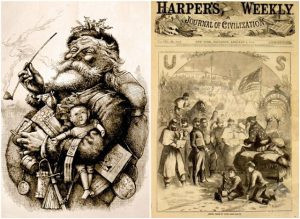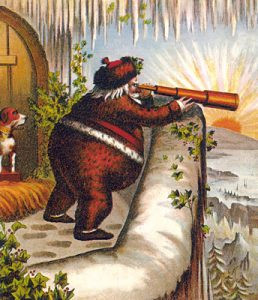The magic of Christmas is often encapsulated by the jolly figure of Santa Claus, his sleigh bells ringing in the frosty air, and the wonder he brings to children worldwide. But Where Did Santa Originate? The story of Santa Claus is a rich tapestry woven from history, folklore, and cultural evolution, stretching back centuries to a real person known for his generosity and kindness.
The Real St. Nicholas: The Origin of Santa
To understand where Santa originated, we must journey back to the 3rd century and the area now known as Turkey. Here, in the town of Patara, around 280 A.D., a man named Nicholas was born. While historical accounts vary, often describing him as a monk and sometimes as a bishop, the common thread is his extraordinary spirit of giving.
Legend recounts that Nicholas inherited a significant fortune from his wealthy parents. However, instead of indulging in luxury, Nicholas dedicated his life and inheritance to helping the less fortunate and the sick. He traveled the countryside, anonymously offering aid and comfort to those in need, embodying the true spirit of selfless generosity. This profound compassion laid the foundation for the figure we now know as Santa Claus.
December 6th marks the anniversary of St. Nicholas’s death and is traditionally celebrated as his feast day. By the Renaissance, St. Nicholas had become the most revered saint in Europe, celebrated for his miracles and generosity. He was officially canonized by Pope Eugene IV on June 5, 1446, further solidifying his status and becoming recognized as the patron saint of children and sailors.
From St. Nicholas to Sinter Klaas: The Dutch Connection
The story of where Santa originated takes a transatlantic turn with the waves of European immigrants who carried their traditions to America. Among these traditions was the celebration of St. Nicholas, particularly by Dutch settlers in New York.
By the late 18th century, “St. Nicholas” was becoming integrated into American culture. Historical records indicate that Dutch families in New York gathered in December 1773 and 1774 to honor St. Nicholas’s anniversary. Crucially, the name “Santa Claus” itself evolved from the Dutch nickname for St. Nicholas: Sinter Klaas. This was a shortened, colloquial form of Sint Nikolaas, the Dutch translation of St. Nicholas, bridging the historical saint with the emerging figure of Santa Claus in America.
Santa’s Arrival in America and Growing Popularity
Gift-giving, a practice deeply rooted in St. Nicholas’s legendary generosity, became increasingly associated with Christmas in the early 19th century. In the United States, the commercial appeal of Christmas and Santa Claus began to take shape. By 1820, stores were advertising Christmas shopping, and by 1840, newspapers featured Christmas advertisements prominently featuring Santa Claus, indicating his growing popularity and association with the holiday season.
In 1841, the allure of Santa Claus was so strong that children flocked to Philadelphia to witness a life-sized Santa model, marking a significant step in the commercialization and popularization of Santa in America. The Salvation Army further cemented Santa’s image as a figure of charity in the early 1890s. They began sending unemployed men dressed as Santa Claus to solicit donations for needy families, a tradition that continues to this day with Salvation Army Santas ringing bells to collect donations during the Christmas season.
Shaping Santa’s Image: Literature and Art
The definitive image of Santa Claus, the one most recognized globally today, owes much to literature and art. A pivotal moment in shaping Santa’s modern persona came with the poem “An Account of a Visit from St. Nicholas,” penned by Clement Clark Moore, an Episcopal minister, for his daughters. This poem, later known as “Twas the Night Before Christmas,” despite Moore’s initial hesitation to publish it, became incredibly popular and influential.
“Twas the Night Before Christmas” introduced the now-iconic version of Santa as a “jolly old soul” with a portly figure, rosy cheeks, and a magical ability to descend chimneys to deliver presents to good children. The poem also popularized the image of Santa traveling in a sleigh pulled by eight flying reindeer, dashing from house to house on Christmas Eve.

Alt text: Jolly Santa Claus face smiling with a white beard and red hat illustration, embodying the modern depiction of Santa Claus.
However, Santa’s visual representation wasn’t always consistent. Before 1931, Santa’s image was quite varied. He was sometimes depicted as a tall, gaunt figure or even a spooky elf. His clothing ranged from bishop’s robes to Norse huntsman’s animal skins, reflecting different cultural interpretations.
During the American Civil War, cartoonist Thomas Nast played a crucial role in standardizing Santa’s appearance through his illustrations for Harper’s Weekly. Initially, Nast portrayed Santa as a small, elf-like figure supporting the Union cause. Over time, Nast refined Santa’s image, notably transitioning his coat from tan to the now-ubiquitous red color, solidifying the visual identity of Santa Claus that we recognize today.

Alt text: Thomas Nast’s Santa Claus drawing for Harper’s Weekly during the Civil War era, showcasing an early depiction of Santa supporting the Union.

Alt text: Nast illustration circa 1869 depicting Santa Claus in a red suit, a significant step towards the modern and universally recognized red-suited Santa image.
Conclusion: Tracing Santa’s Roots
In conclusion, where did Santa originate? The answer lies in the fascinating journey from the historical St. Nicholas, a figure of immense generosity in 3rd century Turkey, to the globally beloved Santa Claus. Through cultural exchange, evolving traditions, literary influence, and artistic interpretations, Santa Claus transformed into the magical embodiment of Christmas spirit. To delve deeper into the history of St. Nicholas and the evolution of Santa Claus, you can visit the St. Nicholas Center.
Sources:

